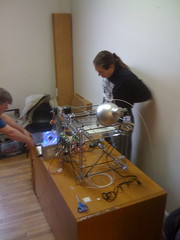“Wow!” “Amazing!” “I want to be involved!” Just some of the comments that I heard during the HacDC RepRap Build-a-Thon yesterday and today. Thanks to the participation of a range of very talented local (and not-so local!) folks, the event was a tremendous success. In particular, thanks to the speakers, Zack “Hoeken” Smith and Adrian Bowyer (virtually, from the UK) as well as the breakout session leaders Adam Koepel and Brian Dolge. Obviously, huge thanks to Nick Farr for organizing the space and activities, as well as to the many HacDC’ers who stayed up into the wee hours working on a Darwin RepRap machine! Keep an eye out for more details on this blog and on the HacDC wiki here. Carl Leonard was also very busy with his video cameras, so I am sure we can expect to see more more about this event on his amazing video blog, Robotcast.
RepRap and DIY Rapid Prototyping Video Podcast
Thanks to fellow dorkbotDC-er Carl Leonard, we have a whole video podcast on DIY rapid prototyping and related technologies. It is a fantastic compliment to the upcoming Build-a-thon. See the video here. This is an episode of the fantastic Robotcast video blog series, every episode of which is packed with robotic goodness! Well worth checking out for interesting points of view on a range of robotics topics!
RepRap Build-a-thon starts on Saturday
Open invitation to anyone interested in rapid prototyping! HacDC is holding a free RepRap Build-a-Thon at HacDC this weekend, Saturday and
Sunday, starting at 10:00am. It is located at the HacDC world headquarters at 1525 Newton St NW in Washington DC (Near corner of 16th and Newton NW).
Attendees will participate in the construction and use of a remarkable open source tool, the “Replicating Rapid Prototyper” or RepRap. Anyone can make a RepRap machine, using parts made by another person with a similar machine, and a few additional parts that can be found online or from a local hardware store. RepRap is capable of making a nearly complete copy of itself, given a small amount of (possibly recycled) plastic. Once the machine is made, the user can download designs for other objects from the Internet or create their own designs, which can then be printed with the RepRap machine.
The two-day sessions will include talks by RepRap founders and pioneers, as well as demonstrations by local experimenters who have
built their own RepRaps and contributed to the development of the system. After the talks, the seminar participants will participate
in the construction of a RepRap from the ground up. Attendees will complete this process during the seminar, providing a great
opportunity for everyone to get some experience assembling and using a RepRap. Smaller breakout sessions on related topics, such as stepper
motor function, microcontroller programming and 3D modeling will be presented, in order to provide the attendees with the skills needed to
construct and use the RepRap system.
The agenda for the Build-a-thon is:
Saturday
Main Auditorium
10:00am Welcome and introductions
10:30am Plenary: “The RepRap Project” by Zach ‘Hoeken’ Smith,
Director, RepRap Research Foundation
11:15am RepRap Technology Overview from Local RepRap Builders
11:45am Activities Outline by R. Mark Adams
12:00pm Break for Lunch
1:00pm Build the Cartesian Robot with Zach ‘Hoeken’ Smith
HacDC Offices
1:00pm Assemble the RepRap Electronics
1:00pm Learn to Solder Breakout with MAKE:DC’s Adam Koeppel
2:00pm Arduino Basics Breakout with HacDC’s R. Mark Adams
3:00pm 3D Modeling for the RepRap with Balt/Wash RUG’s Brian Dolge
5:00pm Close for the day/adjourn to local restaurant for group dinner
Sunday
HacDC Offices
10:00am Complete Electronics Assembly
1:00pm Video Address by RepRap founder Adrian Bowyer, Senior
Lecturer at the University of Bath (invited)
2:00pm Assemble components and print a minimug!
3:00pm Meeting Close
The process of “desktop manufacturing” is coming of age- like the personal computer in the 1970s, such systems are either very expensive, or the purview of a few hobbyists in their garages. But like the personal computer before it, the desktop manufacturing revolution is breaking out. The RepRap, like other open-source projects such as the Linux operating system and the Firefox browser, is allowing anyone with the patience and interest to participate. HacDC and other organizations throughout the world want to see that this technology can be widely understood and utilized by the public. As a result, HacDC (along with other area technology groups such as B/WRUG, Make:DC and DC Dorkbot) are presenting this event, and making it free and open to the public.
The RepRap Project is an initiative aimed at creating a largely self-replicating machine which can be used for rapid prototyping and manufacturing. A rapid prototyper is a 3D printer that is able to fabricate three dimensional artifacts from a computer-based model. Project authors describe ‘self-replication’, understood as the ability to reproduce the components necessary to build another version of itself, as one of the goals for the project. This will allow the number of RepRaps to increase exponentially to meet demand. The authors further speculate that, due to the Open Source nature of the project, RepRap will eventually demonstrate evolution, improving and increasing its capabilities over time. This gives RepRap the potential to become a powerful disruptive technology, similar to the Internet, the home computer, and the automobile. For more information, see the RepRap website at: https://www.reprap.org
Tuesday Seminar Series: Arthacking at Burning Man TONIGHT!
When: Tuesday, January 13, 2009 @ 8:30 pm
Where: HacDC Auditorium (1525 Newton St NW, 20010)
Cost: FREE
[youtube l5R3XNxIjeY]
Dave Monachello will demo and describe the design and implementation of his 2008 Burningman art festival project – ‘I have a dream’ – an animated electroluminescent wire portrait with synchronized sound of Dr. Martin Luther King jr.
Project topics to be covered:
- Project inspiration and design
- What’s el-wire and how do you use it?
- Parallax propeller processor overview
- Programming the propeller
- Creating customized PCBs
- Interfacing devices with an I2C bus
- Using SD cards
- Synchronized sound track creation
- Future enhancements
There should be time for an extended Q & A. Check out the project blog at https://sidnancy.posterous.com


